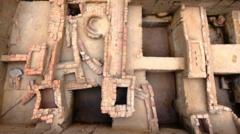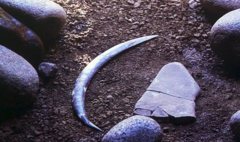In a notable turn for archaeology in India, a 1,000-year-old human skeleton discovered in a sitting, cross-legged position has finally been moved to a dedicated museum after remaining unprotected for six years at its excavation site in western Gujarat. Initially reported earlier this month, the skeleton had been languishing under a makeshift tarpaulin shelter since it was unearthed in 2019 due to bureaucratic delays and disputes over custodianship.
On Thursday, curators from the Archaeological Experiential Museum in Vadnagar successfully transported the ancient remains to the museum, just a short distance from its original location. Mahendra Surela, the museum curator, emphasized that the skeletal remains were handled with "utmost care" during the transition, under the watchful eye of experts from the Archaeological Survey of India (ASI), the government agency responsible for archaeological preservation in India.
Following its arrival, the skeleton is currently on display near the museum's reception, surrounded by a protective barrier to ensure its safety while awaiting a more permanent arrangement. Officials are currently considering relocating it to the second floor, where a photograph of the skeleton is already displayed.
Abhijit Ambekar, the archaeologist who made the discovery, expressed his satisfaction that the skeleton is finally receiving the recognition it deserves. He previously stated that such skeletons are rare, with only three other similar finds documented in India. Experts believe it dates back to the Solanki period, a dynasty that ruled parts of Gujarat from 940 to 1300 CE.
One of the skeleton's remarkable attributes is its survival through the ages, attributed to the undisturbed soil surrounding it, which has helped preserve its condition. Ambekar noted that the remains could provide significant insights into the ancient Hindu practice of "samadhi burials," where revered figures were buried rather than cremated, shedding light on the cultural and historical practices of that epoch.
On Thursday, curators from the Archaeological Experiential Museum in Vadnagar successfully transported the ancient remains to the museum, just a short distance from its original location. Mahendra Surela, the museum curator, emphasized that the skeletal remains were handled with "utmost care" during the transition, under the watchful eye of experts from the Archaeological Survey of India (ASI), the government agency responsible for archaeological preservation in India.
Following its arrival, the skeleton is currently on display near the museum's reception, surrounded by a protective barrier to ensure its safety while awaiting a more permanent arrangement. Officials are currently considering relocating it to the second floor, where a photograph of the skeleton is already displayed.
Abhijit Ambekar, the archaeologist who made the discovery, expressed his satisfaction that the skeleton is finally receiving the recognition it deserves. He previously stated that such skeletons are rare, with only three other similar finds documented in India. Experts believe it dates back to the Solanki period, a dynasty that ruled parts of Gujarat from 940 to 1300 CE.
One of the skeleton's remarkable attributes is its survival through the ages, attributed to the undisturbed soil surrounding it, which has helped preserve its condition. Ambekar noted that the remains could provide significant insights into the ancient Hindu practice of "samadhi burials," where revered figures were buried rather than cremated, shedding light on the cultural and historical practices of that epoch.






















